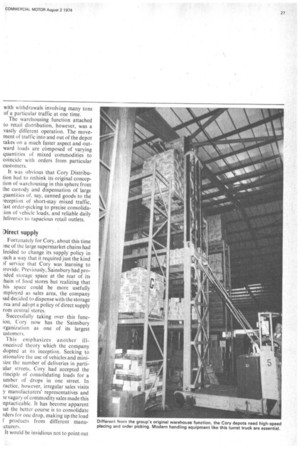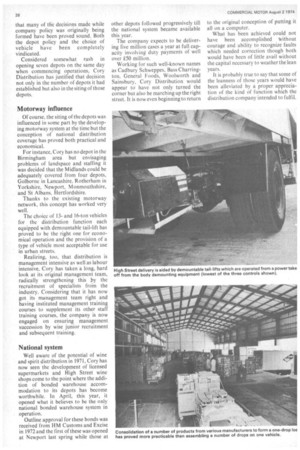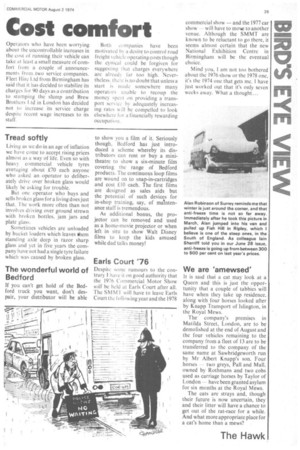Identification of objectives can
Page 28

Page 29

Page 30

Page 31

If you've noticed an error in this article please click here to report it so we can fix it.
save money by Johnny Johnson
ONE of the first principles of marketing is undoubtedly correct identifica-, lion of the market. Before deciding that one has the capital, the know-how and the vehicles to break into a particular haulage sector it is prudent to be sure that all the implications of operating in that field are fully considered. Failure to do so can be costly as the Wm Cory group found after it had decided to go into High Street distribution in 1971.
Undeterred by the problems arising from a multiplicity of commercial vehicles vying with public transport and private cars for kerb and road space and undaunted by the artificial constraints of delivery 'times and days imposed by shop managers, it announced about three years ago that it was launching Cory Distribution Services.
The new distribution company was designed to function with computer
ized routeing and loading from a nationwide network of seven depots supplying retail outlets with essential goods. At the time, there was undoubtedly a need for such a service but business did not develop in the way that it should according to the company's forecasts. The way turned out to be hard and long and the computer concept was put on one side, at least for the time being.
Misconceptions
After three lean years, however, which included a takeover by Ocean Transport and Trading Ltd, Cory Distribution expects to notch up a turnover in excess of £6 million this year and once again the poSsibility of using a computer to monitor the operation is being considered. Though all might be well that ends well, I asked operations'
director and deputy general managei Derek Collinson what had inhibited th( development of the Cory service so thai it had not prospered as had at first beer envisaged.
Mr Collinson acknowledged frank13 that there had been misconception! about the market in the first place Perhaps the most significant of these, explained, had been to assume that th( Cory group had the know-how.
Traditionally. Thamesside ware house and lightermen, the group hac considered that its warehouse expertist would be appropriate for the depo function of the retail delivery function It quickly found out, however, tha there was a fundamental difference.
The kind of warehousing with whicl the company was familiar had involve( the billk storage of large quantities o goods mainly over considerable period with withdrawals involving many tons of a particular traffic at one time.
The warehousing function attached to retail distribution, however, was a vastly different operation. The movement of traffic into and out of the depot takes on a much faster aspect and outward loads are cOmposed of varying quantities of mixed commodities to coincide with orders from particular customers.
It was obvious that Cory Distribution had to rethink its original conception of warehousing in this sphere from the custody and dispensation of large quantities of, say, canned goods to the reception of short-stay mixed traffic, fast order-picking to precise consolidation of vehicle loads, and reliable daily deliveries to rapacious retail outlets.
Direct supply
Fortunately for Cory, about this time )ne of the large supermarket chains had decided to change its supply policy in ;uch a way that it required just the kind )f service that Cory was learning to wovide. Previously, Sainsbury had profided storage space at the rear of its :hain of food stores but realizing that his space could be more usefully !mployed as sales area, the company iad decided to dispense with the storage irea and adopt a policy of direct supply rum central stores.
Successfully taking over this funcion, Cory now has the Sainsbury irganization as one of its largest ustorners.
This emphasizes another illonceived theory which the company dopted at its inception. Seeking to ationalize the use of vehicles and minilize the number of deliveries in partiuIar streets. Cory had accepted the rinciple of consolidating loads for a umber of drops in one street. In ractice, however, irregular sales visits y manufacturers' representatives and le vagary of commodity sales made this npracticable. It has become apparent at the better course is to consolidate rders for one drop, making up the load I products from different manuiCtUrers.
It would be invidious not to point out that many of the decisions made while company policy was originally being formed have been proved sound. Both the depot policy and the choice of vehicle have been completely vindicated.
Considered somewhat rash in opening seven depots on the same day when commencing operations, Cory Distribution has justified that decision not only in the number of depots it had established but also in the siting of those depots.
Motorway influence
Of course, the siting of the depots was influenced in some part by the developing motorway system at the time but the conception of national distribution coverage has proved both practical and economical.
For instance, Cory has no depot in the Birmingham area but envisaging problems of landspace and staffing it was decided that the Midlands could be adequately covered from four depots, Golborne in Lancashire, Rotherham in Yorkshire, Newport, Monmouthshire, and St Albans, Hertfordshire.
Thanks to the existing motorway network, this concept has worked very well.
The choice of 13and 16-ton vehicles for the distribution function each equipped with demountable tail-lift has proved to be the right one for economical operation and the provision of a type of vehicle most acceptable for use in urban streets.
Realizing, too, that distribution is management intensive as well as labour intensive, Cory has taken a long, hard look at its original management team, radically strengthening this by the recruitment of specialists from the industry. Considering that it has now got its management team right and having instituted management training courses to supplement its other staff training courses, the company is now engaged on ensuring management succession by wise junior recruitment and subsequent training.
National system
Well aware of the potential of wine and spirit distribution in 1971, Cory has now seen the development of licensed supermarkets and High Street wine shops come to the point where the addition of bonded warehouse accommodation to its depots has become worthwhile. In April, this year, it opened what it believes to be the only national bonded warehouse system in operation.
Outline approval for these bonds was received from HM Customs and Excise in 1972 and the first of these was opened at Newport last spring while those at other depots followed progressively till the national system became available this year.
The company expects to be delivering five million cases a year at full capacity involving duty payments of well over £50 million.
Working for such well-known names as Cadbury Schweppes, Bass Charrington, General Foods, Woolworth and Sainsbury, Cory Distribution would appear to have not only turned the corner but also be marching up the right street. It is now even beginning to return to the original conception of putting it all on a computer.
What has been achieved could not have been accomplished Without courage and ability to recognize faults which needed correction though both would have been of little avail without the capital necessary to weather the lean years.
It is probably true to say that some of the leanness of those years would have been alleviated by a proper appreciation of the kind of function which the distribution company intended to fulfil.
Tread softly
Living as we doin an age of inflation we have come to accept rising prices almost as a way of life. Even so with heavy commercial vehicle tyres averaging about £70 each anyone who asked an -operator to deliberately drive over broken glass would likely be asking for trouble.
But one operator who buys and sells broken glass for a living does just that. The work more often than not involves driving over ground strewn with broken bottles, jam jars and plate glass.
Sometimes vehicles are unloaded by bucket loaders whichleaves them standing axle deep in razor sharp glass and yet in five years the company have not had a single tyre failure which was caused by broken glass.
The wonderful world of Bedford
If you can't get hold of the Bedford truck you want, don't despair, your distributor will be able to show you a film of it. Seriously though, Bedford has just introduced a scheme whereby its distributors can rent or buy a minitheatre to show a six-minute film covering the range of Bedford products. The continuous loop films are wound on to snap-in-cartridges and cost £10 each. The first films are designed as sales aids but the potential of such devices for in-shop training, say, of malntenance staff is tremendous.
As additional bonus, the projector can be removed and used as a home-movie projector or when left in situ to show Walt Disney films to keep the kids amused while dad talks money!
Earls Court '76
Despite some rumours to the contrary 1 have it on good authority that the 1976 Commercial Motor Show will be held at Earls Court after all. The SM MT will have to leave Earls Court the following year and the 1978
We are samewsed'
It is said thai a cat may look at a Queen and this is just the opportunity that a couple of tabbies will have when they take up residence, along with four horses looked after by Knapp Transport of Islington, in the Royal Mews.
The company's premises in Matilda Street, London, are to be demolished at the end of August and the four vehicles remaining to the company from a fleet of 13 are to be transferred to the company of the same name at Sawbridgeworth run by Mr Albert Knapp's son. Four horses two greys, Pall and Mall. owned by Rothmans and two cobs used as carriage horses by Taylor of London have been granted asylum for six months at the Royal Mews.
The cats are strays and, though their future is now uncertain, they and their litter will have a chance to get out of the rat-race for a while. And what more appropriate place for a cat's home than a mews?
The Hawk




























































































